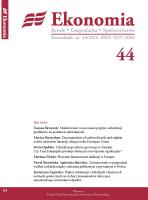Decomposition of carbon dioxide and sulphur oxides emissions intensity change in the European Union
Decomposition of carbon dioxide and sulphur oxides emissions intensity change in the European Union
Author(s): Mariya HnatyshynSubject(s): Economy, Supranational / Global Economy, Energy and Environmental Studies, Sociology, Environmental interactions
Published by: Uniwersytet Warszawski - Wydział Nauk Ekonomicznych
Keywords: economic development; European Union; environmental Kuznets curve; pollution havens hypothesis; primary energy consumption;
Summary/Abstract: The paper tests the environmental Kuznets curve hypothesis, pollution havens hypothesis and evaluates primary energy consumption impacts on emissions. Changes in emissions of examined pollutants in the European Union are in line with the environmental Kuznets curve hypothesis. The turning point is the highest for CO2 and four times lower for SOx. These results indicate that as the economy grows the demand for a clean local environment grows first, and is followed by the demand for clean global environment. More intense external trade reduces CO2 and SOx emissions, which provides evidence for the pollution havens hypothesis. Primary energy consumption in the EU has a statistically significant positive effect on examined emissions. Europe’s energy sector (and Polish in particular) is very dependent on fossil fuels. Despite the existing problems, the EU can serve as an example of sustainable development for less developed countries.
Journal: Ekonomia. Rynek, Gospodarka, Społeczeństwo
- Issue Year: 2016
- Issue No: 44
- Page Range: 31-50
- Page Count: 20
- Language: English

